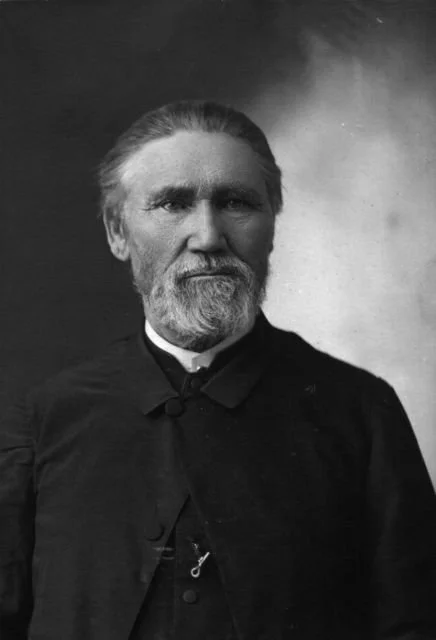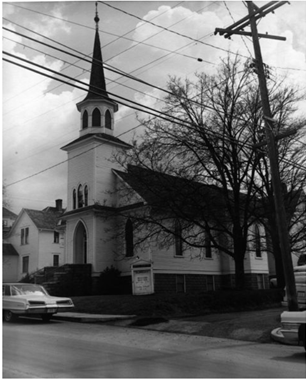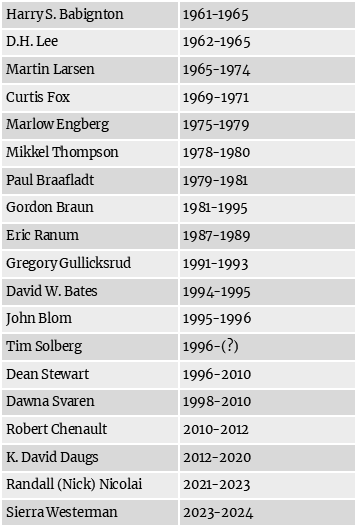HISTORY
EMMANUEL’S HISTORY
We’ve been in Moscow since 1884 (First Lutheran; Swedes) and 1902 (Our Savior’s; Norwegians). The congregations merged to form Emmanuel Lutheran in 1961, moving into our current sanctuary in 1968. We belong to the Evangelical Lutheran Church in America and became Idaho’s first Lutheran Reconciled in Christ congregation in 2009.
The Roots of First Lutheran Church, the Swedish Lutheran Church
The seeds of beginning for the Swedish Lutheran Church were first sown on Christmas Day in 1883 as large snowflakes floated down, blocking roads and hiding mountains. The Olof Olson and A.P. Magnusson families, who had gathered at Gustaf Johnson’s home, were greatly disappointed because they were expecting the Reverend Peter Carlson for dinner and he was to tell them the familiar Christmas Story. Carlson was a traveling missionary who assisted in the organization of many churches in the Pacific Northwest. This Christmas he was traveling from the settlement of Lenville, southeast of Moscow, where he was living with his sons. He had just dedicated the new Cordelia Church on December 7, 1883 and knew the territory well. The snow piled high, and dinner served without the expected guest. But late in the afternoon a sleigh pulled up to the door. Pastor Carlson had come! So begins the story of Emmanuel Lutheran Church.
In the spring of 1884, Moscow was growing as other Swedish families moved from Minnesota. Notably, Allen (Erland) Ramstedt and family came from the Vista Congregation, near Waseca Minnesota. They were active in the formation of a group of worshipers. John, son of Erland, was confirmed on July 27, 1884 in Moscow although his formal training occurred when they lived in Minnesota, and is reported to have been the first Lutheran conferment in the Idaho territory. Another son, Carl, would later become the pastor in Moscow.
In the fall of 1884, Carlson held a series of Sunday worship meetings. Although the group was small, their sentiment was a growing to form a regular organization. Pastor Carlson called the organization meeting on October 12; the first church record read: Protocol of transaction at a legally announced meeting with the Swedes in the town of Moscow, Idaho Territory, on the 12th day of October, 1884 in the act and meaning of organizing a Swedish Evangelical Lutheran congregation. Meeting opened with Bible reading and Prayer by Pastor P. Carlson and remarks, his text was Matthew 13:31-32. … Pastor P. Carlson was elected Temporary Chairman and Olof Olson secretary for one year. The question of organizing a Swedish Evangelical Lutheran Congregation was placed before those assembled (13 adults). Those families present and agreed to organize were Gustaf Johnson, Allen Ramstedt, P.J. Sundell, Olof Olson, John O. Olson, Widow Berta Olson, and Mrs. Lessa Karin Magnusson. The official name of the first church was the Swedish Evangelical Zion Congregation in Moscow, Idaho Territory, although history records the name would change a year later.
The Swedish Lutheran community would ultimately build two churches before the 1961 merger, but the first one had a slow start. After the October 12, 1884 organization meeting, members met regularly for song and prayer with periodic visits from Pastor Peter Carlson. Carlson took a bold step to establish a building in Moscow by borrowing $200 to purchase a lot on the corner of Second and Van Buren streets from William J. McConnell, who would later become governor of Idaho.
The small congregation met on January 5, 1885 while Carlson was absent, to consider purchasing the lot from the pastor. The price was fair given the location, which history shows produced many benefits, but at the time it was looked on as a mixed blessing. The town was expanding eastward and few members lived near the property. Officially the record shows they deliberated and decided, “It appears agreed that we are too few and too poor at this time to do anything about the lot.”The second attempt to purchase the lot was made on October 22, 1885 with new optimism because the membership continued to grow. The group purchased the lot from Carlson in October 1885 and resolved to incorporate under the new name of the First Lutheran Church. The following June, in 1886, Pastor Carlson was called by the country (Cordelia) and Moscow (First Lutheran) churches to be their permanent pastor. For serving Cordelia and First Lutheran, Carlson received $6 per male and $4 per female member per year.
The Moscow church then grew at an amazing rate. Hula Johnson, daughter of founding member Gustaf Johnson, would later write, “…there was not room in any of the homes for services, so we were in the Presbyterian church and then in the Methodist church …” In the fall of 1886, the congregation started to raise funds to construct a church. Construction started in 1887 and, after three years of volunteer labor, was completed in 1890. It was a simple frame building measuring 28 by 40 feet with a tower on the southeast corner. The total cost of construction was about $1,500 and all but $350 had been raised by the members.
The formal dedication ceremony for First Lutheran Church was on February 16, 1890. Pastor J.W. Skans of Portland officiated with the assistance of Pastors Peter Carlson and G.A. Anderson. Also present were two theological students, Carl Ramstedt and S. G. Youngert. Carl, son of founding member Erland Ramstedt, returned in 1892 to serve as pastor of First Lutheran. Now with a suitable building in which to worship, the congregation grew rapidly.
In 1897, Moscow was being wired for electric lighting. The generator was located at the sawmill on the corner of 6th and Jackson streets; the sawmill sold surplus power. The church youth paid for the electrification of the church. The Young People’s society met at the church one evening a week and was required to contribute wood and coal for heat, and kerosene for lighting. This literary society conducted debates on many subjects, made crafts to raise money for missions and produced a handwritten newspaper.
By 1897, First Lutheran had more than 250 members and was the largest church in the Columbia Conference. Growing pains were evident as they were still using the small building started by Pastor Carlson a decade earlier. Subsequently, a Building Committee was formed with these members: G.E. Anderson, F.M. Gustafson, C.B. Green, Gustaf Johnson, J.T. Johnson, N.A. Nelson, P. Nelson, and Pastor N.J.W. Nelson. Gustaf Johnson reported the old church was sold to a St. Peter’s Lutheran Church and moved to the south-east corner of Third and Howard streets. History does not record how the church was moved.
and the Norwegian Lutheran Church to merge into Our Savior’s. It’s not clear how the Moscow congregations chose Our Savior’s as the name for the merged church. It may have come from Pastor Grimsrud, who served the two churches being merged in Genesee (Trinity and Our Savior’s) and the Norwegian church of Moscow from 1912 to 1918, or a former member of the Genesee church.
In 1948, the church was enlarged to provide individual Sunday school rooms, a new kitchen, office, and sanctuary, all of which enlarged the church auditorium and social room. The addition cost $25,000, which included a new organ. More than 400 attended the dedication of the new addition and organ. In 1954, new maple pews with beige plastic cushions were added. The old pews must have been in bad shape and very hard, or the sermon was exceptional because the church elders proudly reported the funds were raised to replace them on a single October day.
In 1957-58, the church built a new parsonage for Pastor Lokken at 1021 East Fifth Street. The old parish house just to the east of the church was converted to Sunday school classrooms in May of 1958.
Emmanuel Lutheran Church
Work on the new church was started in 1905 and completed in 1906. The new building was 4 times the size of the old church. A bell tower was located in the southeast corner, but, interestingly, never held a bell. The new church cost more than $5,000 to construct, was a welcome sight to the 288 members, and was dedicated on March 11, 1906 during the Columbia Conference. Martin L. Larson, Conference President, presided and was joined by other pastors attending the conference.
In 1945, Mrs. Frances Olson Gram, whose father Andrew Olson gave the land for Cordelia Lutheran, gave a baptismal font to the church in memory of her parents. The church structure remained unchanged until new windows were installed in 1947. The Ladies Aid Society furnished new electric light fixtures and new front doors were installed in 1948.
After the merger with Our Savior’s Lutheran Church in 1961, services rotated between churches until May 13, 1962. The building was sold in 1964 to the Senior Citizens Club, which used the church as a social club where Pinochle, shuffleboard, and other games were played. The group made major modifications to the building to “de-Lutheranize” it. They replaced the stain glass windows, removed pews, and furnishing, and added a shuffleboard court. Depending on whom you talk to, the bell tower either fell off and what remained was taken down, or it was taken down during the remodeling process. Bill Anderson recalls it was deemed unsafe by church elders during his youth and had been condemned for a while before the tower fell and/or was taken down. Regardless of what they did to the building, from the outside it still looked like a former Swedish church.
The Unitarian Church of the Palouse purchased the building in 1985 and the senior’s group moved their meetings to the Latah County Fairgrounds. After considerable renovation and lots of work, the Unitarian Church was dedicated on October 17, 1985, almost 100 years after the First Lutheran Congregation agreed to purchase the land to build a church.
The Roots of St. Peter’s Lutheran Church, a Norwegian Lutheran Church
When I started writing this history, the traditional story was that Emmanuel had its roots in two church communities (Our Savior’s, the Norwegians, and First Lutheran, the Swedes) that merged in 1961. When cataloging the historic papers of Victoria Olson given to the Friends of Cordelia by her family, I realized that was not the case. The first evidence of “a missing church” was a dead-end lead from the written history of First Lutheran, which reported the first building was sold to a Lutheran Church and moved to the corner of Third and Howard streets in 1905. Olson’s papers, however, provide a clearer story. Her papers indicate the land for the new location of the church was donated by E. Arneson, a founding member of the congregation, and that this church, St Peter’s, shared a pastor with the Norwegians of Our Savior’s Lutheran in the Thorn Creek area, now part of Genesee Valley Lutheran. The Moscow (St. Peter’s) and Genesee (Our Savior’s) Norwegian Lutheran congregations survived until the merger of three Lutheran Synods in 1917. The Norwegians of Moscow’s St. Peter’s continued to worship in the former, relocated church of the First Lutheran Swedes until 1918 when St. Peter’s merged with Our Savior’s Lutheran in Moscow. The property was deeded to Our Savior’s of Moscow and the building was rented to the Church of the Nazarene. The merger was not as smooth as hoped, and in 1922 it was decided to resume independent services again. The building and property were deeded back to the St. Peter’s congregation. The Moscow Morning Star newspaper reports the 1923 Easter Service was at 11:00 am with Sunday school at 10:00. Services were held until 1927 when the congregation decided to dissolve the organization. A few members rejoined Our Savior’s Lutheran. The church sat vacant until 1930 when it was torn down by Knute Hippe, who used the lumber on his ranch southwest of the city.
The Roots of Our Savior’s Lutheran Church, a Norwegian Lutheran Church
When writing history, you work with the material at hand and often much is missing. Such is the case when researching the early years of Our Savior’s. It would appear the Norwegian members were either having too much fun to record history or wanted to forget the past. Their 50th Anniversary book reports the following for history: “The Congregation was organized by the Reverend Iver Andreassen who was living near the present site of Deary. He was followed by Pastor Carl J. Olsen, of Genesee Valley, who helped out until the first resident Pastor, Reverend Christian. S. Thompson, came to Moscow. The lay organizers of the Congregation were Andrew Andreassen, John Bue, Tobiasen, Sather, Burke, and H.P. Eggan Families.” The pamphlet had little text on history but lots of pictures of the congregation in 1952, including Fritz and Dale Flomer, Grace Lyon, Helen Olson, and Clarence Johnson with his accordion.
Much of Our Savior’s history was recorded indirectly when Our Savior’s Ladies Aid Society wrote their history in 1942. Officially Our Savior’s Lutheran celebrates their organization date as November 15 or 16, 1902 under the name of the “Norwegian Lutheran Church”. Roots of the organization started in 1901 and may go back to a country church (Trinity) in Genesee organized in1878. Our Savior’s would share 13 pastors with this country church. Starting in 1901, Rev. Iver Andreassen began visiting a small group of Lutherans of Norwegian extraction in Moscow, and by 1902, Pastor Carol Olson was alternating Sundays between Trinity Lutheran Church near Genesee and the Moscow Norwegians, who worshiped in the Adventist Church on the corner of Third and Almon streets.
The history of the Norwegian Lutheran Church in Moscow would not be complete without writing about the Lutefisk and Smorgaasbord dinners. The Ladies Aid Society started this tradition in January 1903. The first dinner was held at John Bue’s house and they served about sixty before turning away many more. In addition to lutefisk, the meal consisted of meatballs, potatoes, vegetables, flattigroit (baked beans), lefse, flatbroid (flatbread), gubost (special cheese including Primost), blood polse (blood sausage), cromcake (crumb cake), flatignean (Christmas cookie), sandbakkelse, sirupsnappers (pepper cookie), and much more. All this for just 35 cents a plate. The dinner became a yearly event and large crowds came to eat good food. It was common to hold the Lutefisk dinner in December or January and a Smorgaasbord dinner the following month. In 1950, the cost of the dinner had risen to $1.50 for adults and $0.75 for children. Funds raised by the dinners supported mission work and purchased needed items for the church. The use of the dinners as a fundraiser declined after the merger on 1961 and the last one was held in 1969.
The Norwegian founding group purchased the lot on which the present Methodist Church is built (Third and Adams streets) in1902 and planned to construct a church there in 1905. The Methodists wanted the lot for an expanded church, so the two groups got together and traded. In 1904, the Norwegians took possession of the lot and 17-year-old church building used by the Methodists located at 223 East Sixth (Sixth and Jefferson streets). The church was established as the Norwegian Lutheran Church, but after the First World War, the name was changed to Our Savior’s Lutheran when most Norwegian Lutherans merged back into a single synod in 1917.
The name, Our Savior’s Lutheran, or in Norwegian, Vor Frelsers Menighet, was not new to the Palouse. Norwegian settlers in the Thorn Creek area near Genesee organized the first Lutheran church in 1878 calling it Our Savior’s. In 1884, the church divided over a theological debate on salvation and if man had a cooperating role or no role in it. It would take 33 years before the Our Savior’s of the Thorn Creek area and Trinity of Genesee would reunite to create the Genesee Valley Lutheran Church in 1917, and 12 years for Moscow’s St. Peter’s
In 1961, the congregations of First Lutheran and Our Savior’s merged to form Emmanuel Lutheran Church. It was agreed to construct a new facility that would hold both congregations and allow expansion. In the interim, members of Emmanuel evaluated both churches and facilities and decided to sell First Lutheran on May 13, 1962. Services were held in Our Savior’s until Easter Sunday, April 14, 1968, when the congregation started to use the present facility at 1036 West A Street. The new church was dedicated on May 13, 1968. Shortly thereafter, Our Savior’s building and parish house were sold to Grace Baptist Church.
I would like to thank Bill Anderson and Crystal Lokken for additional background information.
By Larry Lass
Originally written 2004. Updated 2022








